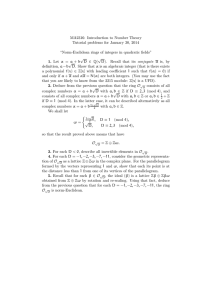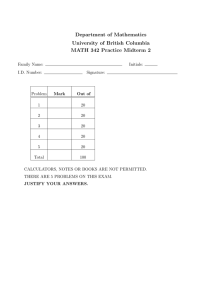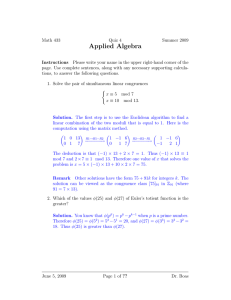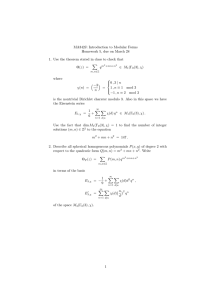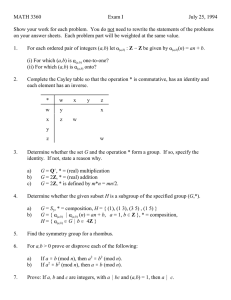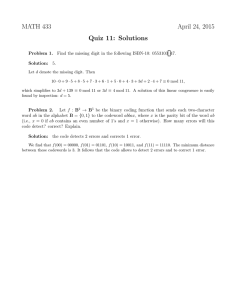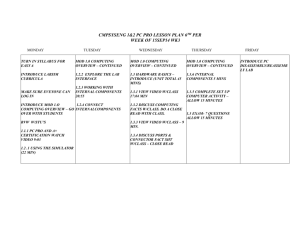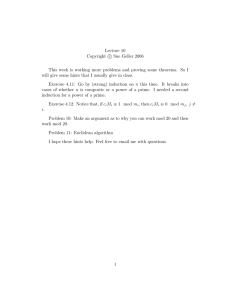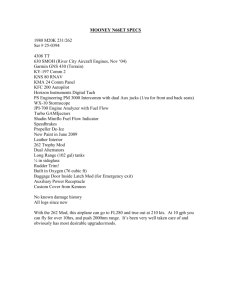Lecture 9: Briefly review groups, subgroups, cosets.
advertisement
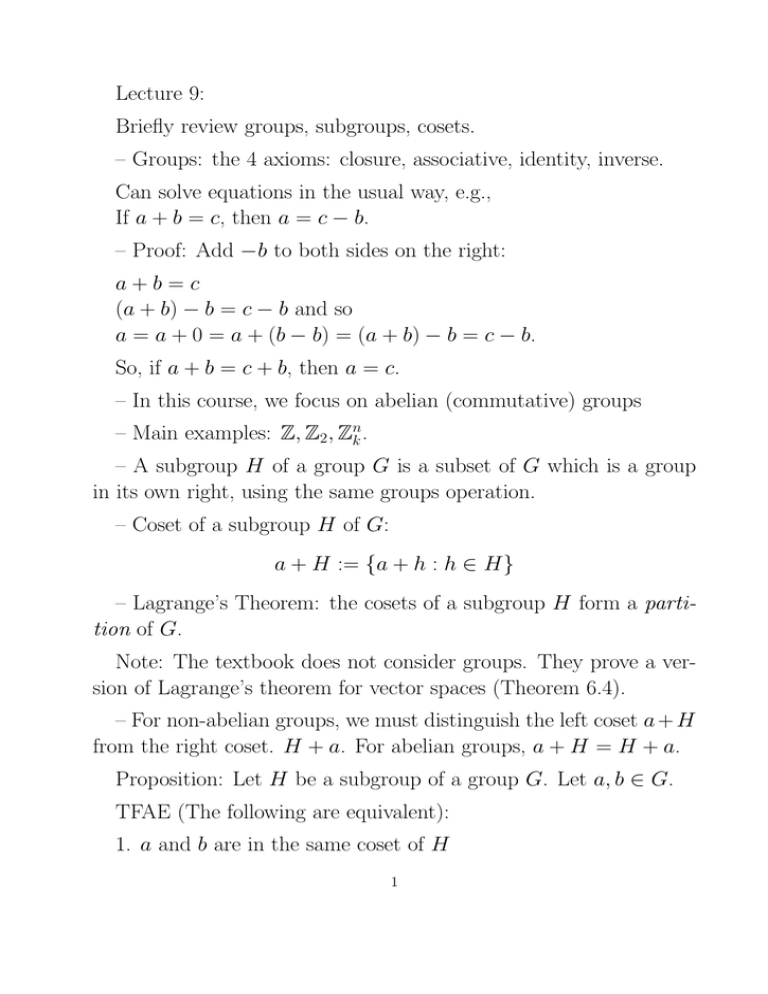
Lecture 9:
Briefly review groups, subgroups, cosets.
– Groups: the 4 axioms: closure, associative, identity, inverse.
Can solve equations in the usual way, e.g.,
If a + b = c, then a = c − b.
– Proof: Add −b to both sides on the right:
a+b=c
(a + b) − b = c − b and so
a = a + 0 = a + (b − b) = (a + b) − b = c − b.
So, if a + b = c + b, then a = c.
– In this course, we focus on abelian (commutative) groups
– Main examples: Z, Z2, Znk.
– A subgroup H of a group G is a subset of G which is a group
in its own right, using the same groups operation.
– Coset of a subgroup H of G:
a + H := {a + h : h ∈ H}
– Lagrange’s Theorem: the cosets of a subgroup H form a partition of G.
Note: The textbook does not consider groups. They prove a version of Lagrange’s theorem for vector spaces (Theorem 6.4).
– For non-abelian groups, we must distinguish the left coset a + H
from the right coset. H + a. For abelian groups, a + H = H + a.
Proposition: Let H be a subgroup of a group G. Let a, b ∈ G.
TFAE (The following are equivalent):
1. a and b are in the same coset of H
1
2. a + H = b + H
3. −b + a ∈ H.
Note: in the abelian case, 3) is the same as a − b ∈ H.
Proof:
1 implies 2: a = a + 0 ∈ a + H and similarly b = b + 0 ∈ b + H;
thus a + H = b + H.
2 implies 3: a ∈ a + H = b + H and so there exists h ∈ H s.t.
a = b + h and so −b + a = h ∈ H.
3 implies 1: If −b+a ∈ H, then there exists h ∈ H s.t. −b+a = h
and so a = b + h ∈ b + H. And b ∈ b + H. Thus, both a and b are
in the coset. Example: G = Z32 and H = the 3-repetition code {000, 111}.
Recall that in Z, we have −1 = 1.
Two distinct words x, y ∈ G are in the same coset iff y − x =
(1, 1, 1) iff x = y + (1, 1, 1), i.e., x, y are binary complements.
So, the cosets are (as done in Lecture 8):
H = {000, 111}, (1, 0, 0) + H = {(1, 0, 0), (0, 1, 1)},
(0, 1, 0)+H = {(0, 1, 0), (1, 0, 1)}, (0, 0, 1)+H = {(0, 0, 1), (1, 1, 0)}
So far, we have considered a group: a set with one operation
that satisfies some axioms. Now, we consider an object with two
operations.
Defn: A field is a set F with two operations + and · that satisfies
the following axioms: for all a, b, c ∈ F
(i) closure: a + b ∈ F, a · b ∈ F
(ii) commutative law: a + b = b + a, a · b = b · a
2
(iii) associative laws: (a + b) + c = a + (b + c), (a · b) · c = a · (b · c)
(iv) distributive law: a · (b + c) = a · b + a · c
(v) additive identity: there exists 0 ∈ F s.t. a + 0 = a.
(vi) multiplicative identity: there exists 1 ∈ F s.t. a · 1 = a.
(vii) additive inverse: there exists b ∈ F s.t. a + b = 0 (we write
−a = b).
(viii) multiplicative inverse: if a 6= 0, there exists b ∈ F s.t.
a · b = 1 (we write a−1 = b).
Notation: sometimes we write (F, +, ·) or (F, ⊕, ).
Note: to say that (F, +, ·) is a field means that:
1. (F, +) is an abelian group
2. (F \ {0}, ·) is an abelian group (or empty in case F = {0})
3. · is distributive over +.
Main example of a field: (R, +, ·).
Examples of other fields:
(Q, +, ·) (rational numbers)
Example of a non-field: (Z, +, ·) satisfies all axioms except for
(viii): 2−1 6∈ Z (i.e., there is no integer b such that 2b = 1).
Defn. A ring is an object (R, +, ·) satisfying (i)-(vii).
So, a ring has all the properties of a field except for multiplicative
inverses of non-zero elements.
Examples of rings: (Z, +, ·) and all fields.
A ring as we have defined it is usually called a commutative ring
with identity.
3
In this course, we focus on finite fields and finite rings.
Example: Zm = {0, 1, . . . , m − 1}, with addition and multiplication, modulo m, here,
— a + b (mod m) is the remainder after division of a + b by m
and a · b (mod m) is the remainder after division of a · b by m
For example, in Z15, 9 + 8 = 2, 5 · 6 = 0.
Example: Z3 = {0, 1, 2}:
+
0
1
2
0
0
1
2
1
1
2
0
2
2
0
1
·
0
1
2
0
0
0
0
1
0
1
2
2
0
2
1
One checks that (Z3, +, ·) is a field. In particular, −0 = 0, −1 = 2,
−2 = 1, 1−1 = 1, 2−1 = 2.
Example: Z4 = {0, 1, 2, 3}:
+
0
1
2
3
0
0
1
2
3
1
1
2
3
0
4
2
2
3
0
1
3
3
0
1
2
·
0
1
2
3
0
0
0
0
0
1
0
1
2
3
2
0
2
0
2
3
0
3
2
1
One checks that (Z4, +, ·) is a ring. In particular, −0 = 0, −1 = 3,
−2 = 2, −3 = 1.
However, (Z4, +, ·) is not a field. For instance, we see that there
is no ‘1’ in the third row of the multiplication table above, indicating
that 2 has no multiplicative inverse; also, as pointed out in class,
Z4 \ {0} is not closed under multiplication because 2 · 2 = 0.
Note that the addition and multiplication tables are symmetric
across the main diagonal because addition and multiplication are
commutative.
5
Lecture 10:
Midterm on Thursday, Feb 11. Will cover material in Lectures 1-8
+ those parts of lectures 9 and 10, having to do with groups, but not
fields and rings.
Includes Zm as an additive group.
Chapters 1 and 2 in text.
We have defined groups, fields and rings. There are lots of nice,
expected things that you can prove, some of which are as follows.
The axioms for a group refer to the existence of an identity element
0 and the existence of an inverse −a for any element a of the group.
We would expect that in a group, the identity and inverses are unique.
Indeed, they are.
Proof of uniqueness of identity:
Suppose that 0 and 00 are both additive identities.
Then 0 = 00 + 0 = 00 (the first equality since 00 is an additive
identity, and the second equality since 0 is an additive identity. Proof of uniqueness of inverses:
Suppose b and b0 are inverses of a. Then
a + b = 0 = a + b0
Thus,
b = 0 + b = (b + a) + b = b + (a + b) = b + (a + b0)
= (b + a) + b0 = 0 + b0 = b0.
It follows that in a field, 0 and 1 are unique, and additive and
multiplicative inverses are unique.
6
Also, in any ring R (in particular, in any field), for all a ∈ R, we
would expect that a · 0 = 0. Indeed this is true:
Proof:
a · 0 = a · (0 + 0) = a · 0 + a · 0
Add −a · 0 to both sides to get: 0 = a · 0.
Recall Zm.
Defn: For integers a, b and a positive integer m, we write a ≡ b
(mod m) if m divides a−b (written m|a−b); equivalently a = km+b
for some integer k
Prop: Addition and Multiplication are well-defined (mod m),
i.e.
1. If a ≡ a0 (mod m) and b ≡ b0 (mod m), then a+b ≡ a0 +b0
(mod m).
2. If a ≡ a0
(mod m).
(mod m) and b ≡ b0
(mod m), then a · b ≡ a0 · b0
Proof: 1. Write:
(a + b) − (a0 + b0) = (a − a0) + (b − b0)
Since m divides a − a0 and b − b0, m divides the RHS and thus the
LHS.
2.
ab − a0b0 = (ab − a0b) + (a0b − a0b0) = (a − a0)b + a0(b − b0)
Since m divides a−a0 and b−b0, m divides the RHS of the preceding
equation and thus divides ab − a0b0. Defn: The Principal Remainder of an integer x ∈ Z is the unique
integer 0 ≤ a ≤ m − 1 s.t. x ≡ a (mod m).
7
Because addition and multiplication (mod m) are well-defined,
we can easily compute principal remainders in Zm. For instance, in
Z6:
75 · 53 = 3 · 5 = 15 = 3 (mod 6).
Last time, we noted that Z3 is a field and Z4 is a ring but not a
field.
In fact, we will show that Zm is always a ring and that Zm is a
field iff m is prime. For this, we use an:
Another viewpoint on Zm:
For a ∈ Z, let [a] = {a0 ∈ Z : a0 ≡ a (mod m)}.
We redefine: Zm := {[a] : a ∈ Z} = {[0], [1], . . . , [m − 1]}, with:
1. addition: [a] + [b] = [a + b]
2. multiplication: [a] · [b] = [a · b]
Well-defined by prop. above.
Theorem: Zm is a ring.
Proof: check ring axioms.
axioms (i)-(iv) are all inherited from Z
For example, associativity:
([a] + [b]) + [c] = [a + b] + [c] = [(a + b) + c] = [a + (b + c)]
= [a] + [b + c] = [a] + ([b] + [c])
(v) and (vi): additive identity is [0] and mult. identity is [1].
(vii): additive inverse: −[a] = [−a] because [a] + [−a] = [0].
Theorem: Zm is a field iff m is prime.
Lemma 1: Let F be a field and a, b ∈ F .
If ab = 0, then a = 0 or b = 0.
8
Proof: Suppose that a 6= 0. It suffices to show that b = 0.
0 = ab implies
0 = a−1 · 0 = a−1 · (a · b) = (a−1 · a) · b = 1 · b = b.
Thus, Z4 is not a field, since 2 · 2 = 0, and Z6 is not a field, since
2 · 3 = 0.
Lemma 2: If m|ab and m is prime, then m divides a or b.
Proof: prime factorization.
Proof of Theorem:
Only if: Suppose Zm is a field. If m is not prime, write m = a · b
where 2 ≤ a, b ≤ m − 1. Thus, in Zm, we have
a · b = 0, a 6= 0, b 6= 0
contrary to Lemma 1 above.
9
